Industry News, trenchless products, trenchless projects
Massive XRE Machine breaks through at Akron OCIT
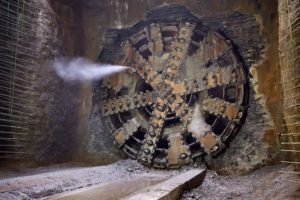 On August 29, 2018, a 9.26 m (30.4 ft) diameter Robbins Crossover (XRE) TBM crossed the finish line at the Akron Ohio Canal Interceptor Tunnel (OCIT). A press day followed on September 5, where companies and members of the media were invited to view the giant machine. The machine—dubbed “Rosie” in honor of Rosie the Riveter, an icon representing American women who worked in factories and shipyards during World War II—overcame tough ground conditions during the bore.
On August 29, 2018, a 9.26 m (30.4 ft) diameter Robbins Crossover (XRE) TBM crossed the finish line at the Akron Ohio Canal Interceptor Tunnel (OCIT). A press day followed on September 5, where companies and members of the media were invited to view the giant machine. The machine—dubbed “Rosie” in honor of Rosie the Riveter, an icon representing American women who worked in factories and shipyards during World War II—overcame tough ground conditions during the bore.
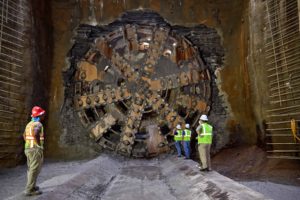 “One of the most challenging aspects of this job was that we launched right into the most difficult part. We had 60 m (200 ft) of soft ground, a very short reach, and then from there we went right into a mixed face for 180 m (600 ft),” said David Chastka, Project Manager for Kenny Construction, a joint venture contractor on the project with Obayashi. “It took everybody we had in the industry, everybody from Robbins, to fight through that first 240 m (800 ft).”
“One of the most challenging aspects of this job was that we launched right into the most difficult part. We had 60 m (200 ft) of soft ground, a very short reach, and then from there we went right into a mixed face for 180 m (600 ft),” said David Chastka, Project Manager for Kenny Construction, a joint venture contractor on the project with Obayashi. “It took everybody we had in the industry, everybody from Robbins, to fight through that first 240 m (800 ft).”
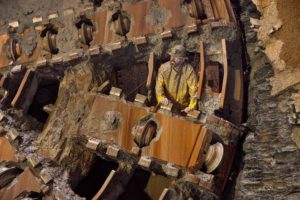 The TBM was designed for the project’s geology, which transitioned from soil to partial face shale to full face shale rock. The Crossover XRE included features of both EPB and Hard Rock Single Shield TBM types, with a versatile cutterhead that could be configured for hard rock or soft ground conditions. While in soft ground and mixed face conditions the machine operated in closed mode, but once it hit solid rock crews switched excavation to open mode. “The machine had the power to get to the other side and made advance rates we never thought we were going to get. It was very successful in hard rock,” said Chastka. Advance rates once in full-face shale rock reached a high of 34 m (111 ft) in one day (two 10-hour shifts). Muck removal was achieved using a Robbins continuous conveyor, and conveyor availability remained high throughout the project.
The TBM was designed for the project’s geology, which transitioned from soil to partial face shale to full face shale rock. The Crossover XRE included features of both EPB and Hard Rock Single Shield TBM types, with a versatile cutterhead that could be configured for hard rock or soft ground conditions. While in soft ground and mixed face conditions the machine operated in closed mode, but once it hit solid rock crews switched excavation to open mode. “The machine had the power to get to the other side and made advance rates we never thought we were going to get. It was very successful in hard rock,” said Chastka. Advance rates once in full-face shale rock reached a high of 34 m (111 ft) in one day (two 10-hour shifts). Muck removal was achieved using a Robbins continuous conveyor, and conveyor availability remained high throughout the project.
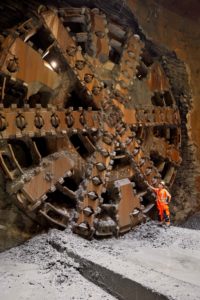 “I am most proud of the team that I have had the pleasure of being a part of,” said Don Smida, Robbins Field Service Technician. The overall scope of a project of this scale is immense, and the amount of daily cooperation & hard work that has been asked of The Robbins Company, the local unions, city staff, and Kenny-Obayashi is extremely important in reaching our common goals. I think we should all be proud of our teamwork going forward from a successful completion of the tunnel and into a successful disassembly of Rosie.”
“I am most proud of the team that I have had the pleasure of being a part of,” said Don Smida, Robbins Field Service Technician. The overall scope of a project of this scale is immense, and the amount of daily cooperation & hard work that has been asked of The Robbins Company, the local unions, city staff, and Kenny-Obayashi is extremely important in reaching our common goals. I think we should all be proud of our teamwork going forward from a successful completion of the tunnel and into a successful disassembly of Rosie.”
Now that tunneling is complete, the machine will be disassembled and removed from its retrieval shaft this autumn. “The Ohio Canal Interceptor Tunnel is the largest public improvement project in our City’s history and a significant investment in our environment and infrastructure that will benefit Akron residents and businesses for generations to come,” said the City of Akron’s Mayor Daniel Horrigan. “Projects of this kind are inherently dangerous, and I am incredibly proud that the tunneling portion was completed without any major injuries, thanks to a dedicated team of professionals. And although Robbins is an international company with worldwide impact, we were pleased to be able to work with a local Northeast Ohio firm on this significant project.”
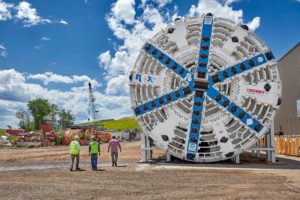 The OCIT Project for the City of Akron, Ohio, USA consists of the construction of a conveyance and storage tunnel system to control Combined Sewer Overflows (CSOs) for several regulators in the downtown Akron area. The EPA-mandated project includes the 1.89 km (1.17 mi) conveyance and storage tunnel, as well as drop shafts, diversion structures, consolidation sewers, and related structures.
The OCIT Project for the City of Akron, Ohio, USA consists of the construction of a conveyance and storage tunnel system to control Combined Sewer Overflows (CSOs) for several regulators in the downtown Akron area. The EPA-mandated project includes the 1.89 km (1.17 mi) conveyance and storage tunnel, as well as drop shafts, diversion structures, consolidation sewers, and related structures.
Image 1: On August 29, 2018, a 9.26 m (30.4 ft) diameter Robbins Crossover TBM broke through at the Akron Ohio Canal Interceptor Tunnel (OCIT).
Image 2: Personnel inspect the Robbins Crossover XRE TBM “Rosie”, named for Rosie the Riveter, after the breakthrough.
Image 3: A crew member cleans the cutterhead of the Robbins Crossover TBM following its breakthrough on August 29, 2018.
Image 4: The Robbins Crossover XRE machine—the first such machine to operate in the U.S.—achieved advance rates of up to 34 m (111 ft) per day in two 10-hour shifts.
Image 5: The 9.26 m (30.4 ft) diameter Robbins Crossover TBM was designed and built in Robbins’ Solon, Ohio, USA facility.
Industry News, trenchless projects
Nepal’s First TBM bores 1,000 Meters in One Month
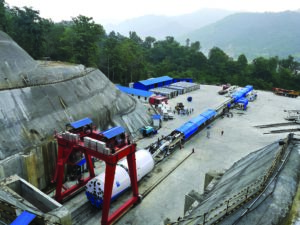 Nepal’s first tunnel boring machine, a 5.06 m (16.6 ft) diameter Robbins Double Shield, is living up to the nation’s high expectations. The TBM, supplied in summer 2017 for the Bheri Babai Diversion Multipurpose Project (BBDMP), recently bored over 1,000 m (3,280 ft) in one month and has been averaging an impressive 800 m (2,630 ft) per month. The project is owned by the Government of Nepal’s Department of Irrigation (DOI) and operated by contractor China Overseas Engineering Group Co. Ltd. Nepal Branch (COVEC Nepal).
Nepal’s first tunnel boring machine, a 5.06 m (16.6 ft) diameter Robbins Double Shield, is living up to the nation’s high expectations. The TBM, supplied in summer 2017 for the Bheri Babai Diversion Multipurpose Project (BBDMP), recently bored over 1,000 m (3,280 ft) in one month and has been averaging an impressive 800 m (2,630 ft) per month. The project is owned by the Government of Nepal’s Department of Irrigation (DOI) and operated by contractor China Overseas Engineering Group Co. Ltd. Nepal Branch (COVEC Nepal).
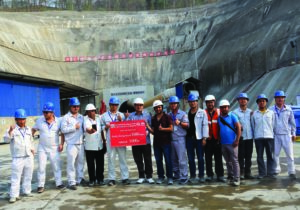 The decision to use a TBM for the BBDMP project—designated by the government as one of Nepal’s 11 National Pride Projects—was a departure for a nation where drill & blast has long been the preferred tunneling method. Early studies done on the tunnel path predicted that drill & blast excavation of the 12.2 km (7.5 mi) tunnel would take close to 12 years to complete. The tunnel is located in the Siwalik Range, part of the Southern Himalayan Mountains, where geology consists of mainly sandstone, mudstone, and conglomerate.
The decision to use a TBM for the BBDMP project—designated by the government as one of Nepal’s 11 National Pride Projects—was a departure for a nation where drill & blast has long been the preferred tunneling method. Early studies done on the tunnel path predicted that drill & blast excavation of the 12.2 km (7.5 mi) tunnel would take close to 12 years to complete. The tunnel is located in the Siwalik Range, part of the Southern Himalayan Mountains, where geology consists of mainly sandstone, mudstone, and conglomerate.
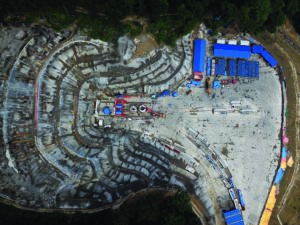 Mr. Wang Wu Shui, General Manager for COVEC Nepal, cited several factors that have contributed to the good advance rates so far, “In China, there is a proverb about TBM construction: ‘geology is the premise, equipment is the foundation, and talents are the key’. The great advance rates achieved at present mainly lie in preliminary planning, process control, and professional construction personnel.” Shui added that technical training and guidance are provided for each position so that all personnel can fully understand their job and team responsibilities. If unforeseen circumstances arise and there is no operator for a certain position, others have enough training to fill the role.
Mr. Wang Wu Shui, General Manager for COVEC Nepal, cited several factors that have contributed to the good advance rates so far, “In China, there is a proverb about TBM construction: ‘geology is the premise, equipment is the foundation, and talents are the key’. The great advance rates achieved at present mainly lie in preliminary planning, process control, and professional construction personnel.” Shui added that technical training and guidance are provided for each position so that all personnel can fully understand their job and team responsibilities. If unforeseen circumstances arise and there is no operator for a certain position, others have enough training to fill the role.
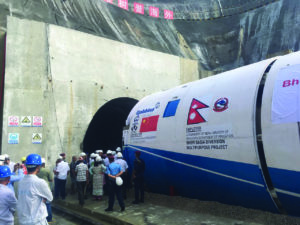 To ensure the best TBM performance and to prevent downtime, machine maintenance occurs daily at a fixed time. Geological engineers are sent to analyze the ground conditions twice daily so that construction personnel can adjust the tunneling parameters and prepare for auxiliary measures if geological changes are predicted.
To ensure the best TBM performance and to prevent downtime, machine maintenance occurs daily at a fixed time. Geological engineers are sent to analyze the ground conditions twice daily so that construction personnel can adjust the tunneling parameters and prepare for auxiliary measures if geological changes are predicted.
The ground conditions during the record-setting month consisted mainly of sandstone and mudstone, but that is set to change. At about the 5.8 km mark, the machine will encounter a major fault zone known as the Bheri Thrust. Clay and water ingress are expected throughout the fault, which is about 400 to 600 m wide.
COVEC Nepal are prepared for the conditions and have worked out efficient tunneling logistics to decrease downtime. “The two working procedures of tunneling and segment erection are carried out simultaneously under the double shield tunneling mode, and the time to erect a ring of segments is 15 minutes in general,” said Shui. “Under the single shield tunneling mode, segment erection comes after tunneling in a sequential process, but the segment erection time is still about 15 minutes.” To further reduce time, consolidation grouting is carried out in advance during daily maintenance to avoid the impact of downtime for grouting on the overall construction progress.
Once complete, the BBDMP will irrigate 60,000 hectares of land in the southern region of Nepal, and benefit an estimated 30,000 households. It will divert 40 cubic meters (1,400 cubic feet) of water per second from Bheri River to Babai River under a head of 150 m (490 ft) using a 15 m (49 ft) tall dam, providing year-round irrigation in the surrounding Banke and Bardia districts. The water will also be used for hydroelectricity, with a generating capacity of 48 MW benefiting the country with NPR 2 billion (20 million USD) annually. The initial success of the TBM operation has already inspired developers and contractors to opt for TBMs over conventional excavation methods on upcoming Nepalese tunnels.
Image 1: A 5.06 m (16.6 ft) Robbins Double Shield TBM has bored over 1,000 m (3,280 ft) in one month at Nepal’s Bheri Babai Diversion Multipurpose Project (BBDMP).
Image 2: The COVEC Nepal crew celebrate the record-setting month of over 1,000 m (3,280 ft) for the Robbins Double Shield TBM boring the BBDMP tunnel.
Image 3: An overhead view of the BBDMP jobsite, located in Bardia Wildlife Reserve, a sanctuary home to tigers, rhinos, elephants and many other types of vulnerable flora and fauna.
Image 4: Launched in summer 2017, the Robbins TBM is the first ever to operate in Nepal and has garnered much national attention for its successful operation.
Industry News, trenchless projects
Long Pull Avoids Draining Major Wetland
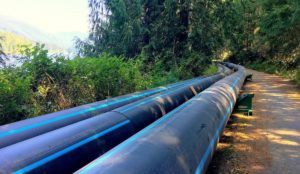 Sliplining is completed by installing a smaller, HDPE pipe into a larger host pipe, grouting the annular space between the two pipes, and sealing the ends. The trenchless method is generally a cost-effective rehabilitation method to replace water and sewer force mains.
Sliplining is completed by installing a smaller, HDPE pipe into a larger host pipe, grouting the annular space between the two pipes, and sealing the ends. The trenchless method is generally a cost-effective rehabilitation method to replace water and sewer force mains.
The original design was to drain the entire wetland that had formed since the original construction of the 36-inch water main and split the slip lining into multiple sections. However, Murphy Pipelines designed and sliplined the entire length in one pull allowing the wetland to remain untouched.
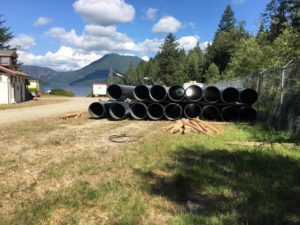 Powell River, BC located in inaccessible area requiring pipe, equipment and workers reach only by ferries.
Powell River, BC located in inaccessible area requiring pipe, equipment and workers reach only by ferries.
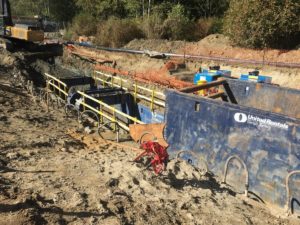 Wellpoints set up at insertion pit.
Wellpoints set up at insertion pit.
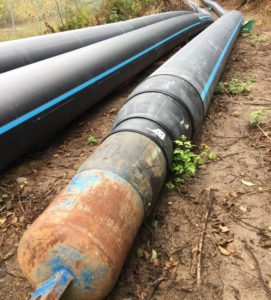 Pull head fused on. Long sections of HDPE pipe staged on old mining road.
Pull head fused on. Long sections of HDPE pipe staged on old mining road.
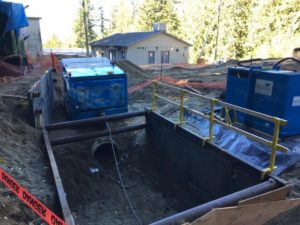 Pulling winch set up ready to start sliplining.
Pulling winch set up ready to start sliplining.
Click here to read the case study on Sliplining in Powell River, BC Canada.
Industry News, trenchless projects
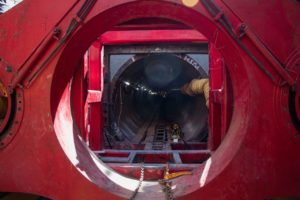 The City and County of Denver has designed the 33rd Street Outfall Storm Sewer to reduce flooding concerns between Downing Street and the Platte River along 33rd Street and the surrounding neighborhoods. The project is being released in four phases over three years, and BTrenchless has completed the first two phases, installing the storm sewer from the Platte River to the intersection of 33rd and Blake.
The City and County of Denver has designed the 33rd Street Outfall Storm Sewer to reduce flooding concerns between Downing Street and the Platte River along 33rd Street and the surrounding neighborhoods. The project is being released in four phases over three years, and BTrenchless has completed the first two phases, installing the storm sewer from the Platte River to the intersection of 33rd and Blake.
The pipeline is a combination of large box culverts, 120” HOBAS pipe, smaller reinforced concrete pipe, and steel casings. The highlight of the first phase was construction of a precast 11’ x 8’ concrete box culvert across Brighton Blvd. while maintaining a constant flow of traffic. The second phase included a 220’ long tunnel, ten foot in diameter, under the Union Pacific Railroad Yard and the RTD Commuter Rail. It also included side-by-side 96” diameter steel tunnels under Blake Street and a 450 foot long, 51” HOBAS storm lateral via a microtunnel method.
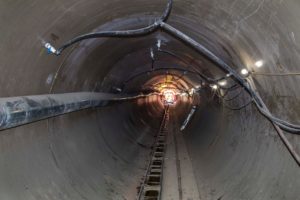 The diversity of this project allowed BTrenchless to utilize three different types of tunnels and capitalized on the vast resources of both people and equipment to successfully complete this complex and high profile project. In the course of the first two phases, nine different crews and four different superintendents had a part in the overall success of the project, each capitalizing on their various areas of expertise.
The diversity of this project allowed BTrenchless to utilize three different types of tunnels and capitalized on the vast resources of both people and equipment to successfully complete this complex and high profile project. In the course of the first two phases, nine different crews and four different superintendents had a part in the overall success of the project, each capitalizing on their various areas of expertise.
Click on photos to view larger images. Be sure to notice Morty the Tunnel Rat in the top photo supervising the project!
Industry News, trenchless projects
Massive Metro Project Will Improve Traffic and Rail Congestion in One of India’s Largest Cities
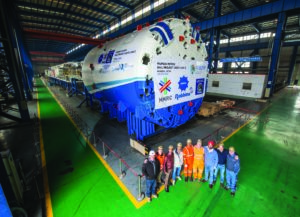 On June 11, 2018, a Robbins Crossover XRE destined for Line 3 of India’s Mumbai Metro arrived in Mumbai port following a successful factory acceptance test in April. The machine, combining features of a hard rock Single Shield TBM and an Earth Pressure Balance Machine, is one of two 6.65 m (21.8 ft) Crossover machines that will bore under contract UGC-01. Operation of these two machines will be carried out by Larsen & Toubro, part of the Larsen & Toubro -Shanghai Tunnel Engineering Co Joint Venture (L&T-STEC JV). The Robbins Company will provide key personnel for the initial boring phase. “During the factory acceptance testing, we observed that the machine and back-up system are robust enough for hard rock tunneling,” stated Palwinder Singh, Head of Tunnel Operations for L&T-STEC JV.
On June 11, 2018, a Robbins Crossover XRE destined for Line 3 of India’s Mumbai Metro arrived in Mumbai port following a successful factory acceptance test in April. The machine, combining features of a hard rock Single Shield TBM and an Earth Pressure Balance Machine, is one of two 6.65 m (21.8 ft) Crossover machines that will bore under contract UGC-01. Operation of these two machines will be carried out by Larsen & Toubro, part of the Larsen & Toubro -Shanghai Tunnel Engineering Co Joint Venture (L&T-STEC JV). The Robbins Company will provide key personnel for the initial boring phase. “During the factory acceptance testing, we observed that the machine and back-up system are robust enough for hard rock tunneling,” stated Palwinder Singh, Head of Tunnel Operations for L&T-STEC JV.
During the bores, consisting of parallel 2.8 km (1.7 mi long) tunnels, geologic conditions will include mixed ground and possible water pressures up to 2 bar. According to Singh, “A Crossover XRE was chosen because of the expected geology,” which includes basalt rock and transition zones consisting of black carbonaceous shale, tuff, and breccia. Rock strengths are anticipated to range between 15 MPa and 125 MPa (2,200 and 18,100 psi) UCS. The machines will bore with only 15 to 20 m (50 to 70 ft) of cover above the tunnel and the structure will be lined with reinforced concrete segments in a 5+1 arrangement.
The metro tunnels will run between the Cuffe Parade Station and Hutatma Chowk station, passing through the Vidhan Bhavan and Church Stations. Both Crossover machines will be launched from the same 25 m (82 ft) deep by 22 m (72 ft) long shaft at the Cuffe Parade Station. “The limited length of the shaft requires running the TBMs for the first 100 m (328 ft) with some or all the back-up decks at the surface,” said JP Bayart, Robbins Project Engineer. “The TBMs and back-up systems are connected with umbilical cables and hoses.”
The TBMs will begin their excavation in hard rock mode. “Each cutterhead is optimized for operation in rock, as this is what is expected. The machines can also operate in soft ground thanks to the screw conveyor with bulkhead gate and discharge gate,” said Bayart. “The Robbins Torque-Shift System, consisting of two-speed shifting gearboxes coupled to the main drive motors, allows for the high cutterhead torque required for soft ground operation.” The face of each machine is equipped with six muck buckets and six large internal muck loading plates. This design, in combination with the screw conveyor located at the centerline of each machine, will allow for the option of fully emptying the cutterhead chamber, resulting in minimal wear when EPB mode is not required. Muck will be removed from the tunnels via muck cars.
Assembly and launch preparations for the first XRE TBM began on 20 June and are estimated to take about six weeks. The second Robbins XRE TBM underwent factory acceptance testing at the end of May and will arrive at the jobsite at the end of July for its assembly. “Our target is to achieve an average of 250 m (820 ft) of boring per month,” said Jim Clark, Robbins Projects Manager India. “The target to complete the boring operations is 20 months, which includes the additional time required for the short start-up using umbilicals on the initial drives, dragging the machines and re-launching through three stations.” Contractor L&T plans to work crews on double shifts to cover a full day of operations in order to keep to this timeline. The machines will join two Robbins Slurry machines boring a separate contract of the Mumbai Metro Line 3. The first of those machines will be launching in August 2018. The Metro Line 3 project as a whole is estimated to be completed by 2021.
Image: Robbins and contractor personnel stand proudly in front of the first of two Robbins 6.65 m (21.8 ft) diameter XRE TBMs during the factory acceptance test.
Industry News, trenchless projects
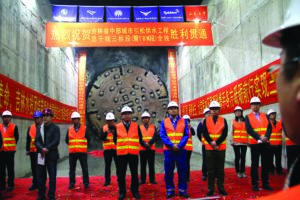 Hard Rock Machine crosses Finish Line Nearly Five Months Ahead of Schedule
Hard Rock Machine crosses Finish Line Nearly Five Months Ahead of Schedule
In mid-May 2018 the national-record-setting 7.9 m (26 ft) Robbins Main Beam TBM at the Jilin Lot 3 Tunnel broke through. A formal ceremony followed to commemorate the stellar performance of the tunneling operation and its early completion. “I have participated in this project from the beginning. The project broke through 147 days earlier than scheduled. The project has achieved the fastest monthly advance rate record–1423.5 m/4,670 ft—for 7 to 8 m (23 to 26 ft) diameter TBMs in China. And the machine has reached over 1000 m (3,280 ft) per month for three consecutive months. I am so proud of these achievements,” said Mr. Wu Zhi Yong, Vice Chief Engineer and Jilin Yinsong Project Vice General Manager for contractor Beijing Vibroflotation Engineering Co. Ltd. (BVEC).
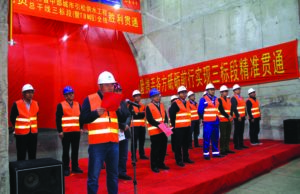 The completion of the 24.3 km (15 mi) tunnel nearly five months ahead of schedule is a monumental achievement considering the difficult ground conditions encountered. Rock types ranged from tuff to granite, sandstone, and andesite with multiple fault zones—conditions requiring nearly continuous ground support. Rock strengths varied widely from 35 to 206 MPa UCS (5,100 to 30,000 psi). The contractor cited a number of factors that contributed to the swift advance rates: “It is the stable and reliable performance of the Robbins machine, and the professional technical skills of the service technicians. The Robbins crew coordination, reasonable working progress arrangements and the sophisticated technology all allowed the project to make the fast advance rate,” said Mr. Wu.
The completion of the 24.3 km (15 mi) tunnel nearly five months ahead of schedule is a monumental achievement considering the difficult ground conditions encountered. Rock types ranged from tuff to granite, sandstone, and andesite with multiple fault zones—conditions requiring nearly continuous ground support. Rock strengths varied widely from 35 to 206 MPa UCS (5,100 to 30,000 psi). The contractor cited a number of factors that contributed to the swift advance rates: “It is the stable and reliable performance of the Robbins machine, and the professional technical skills of the service technicians. The Robbins crew coordination, reasonable working progress arrangements and the sophisticated technology all allowed the project to make the fast advance rate,” said Mr. Wu.
The Robbins Main Beam TBM bored through a total of 24 fault zones utilizing a unique combination of steel McNally slats (extruded through pockets in the TBM roof shield to prevent movement of loose rock), wire mesh, and shotcrete. The TBM was specifically designed to tackle the tough conditions. “Under the variable ground conditions, especially weak, soft, and fractured rock, the optimized system and reasonable design of the machine ensured effective tunneling progress. Robbins’ unique gripper system, continuous propel system, hydraulic drives, roof support and stable cutterhead reduced the wear of cutters.The efficient belt conveyor inside the main beam allowed quick muck removal from the cutterhead to the back of the machine, which ensured the good progress of the TBM,” said Mr. Wu.
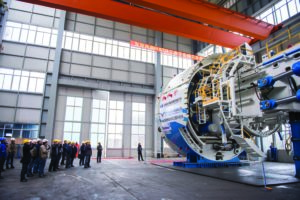 The Jilin Lot 3 tunnel is part of the Jilin Yinsong Water Supply Project, which at 736.3 km (457.5 mi) is China’s largest scale water diversion project to date. Once operational the water lines will divert the water from Fengman Reservoir at the upper reaches of Di’er Songhua River to central regions of Jilin Province experiencing chronic water shortages. These regions include the cities of Changchun and Siping, eight surrounding counties, and 26 villages and towns under their jurisdiction. The project will optimize water resource distribution, improve regional eco-systems, and ensure better food production and water safety for the people of Jilin Province.
The Jilin Lot 3 tunnel is part of the Jilin Yinsong Water Supply Project, which at 736.3 km (457.5 mi) is China’s largest scale water diversion project to date. Once operational the water lines will divert the water from Fengman Reservoir at the upper reaches of Di’er Songhua River to central regions of Jilin Province experiencing chronic water shortages. These regions include the cities of Changchun and Siping, eight surrounding counties, and 26 villages and towns under their jurisdiction. The project will optimize water resource distribution, improve regional eco-systems, and ensure better food production and water safety for the people of Jilin Province.
Image 1: The record-setting Robbins TBM broke through nearly five months ahead of schedule on China’s Jilin Lot 3 Tunnel.
Image 2: A formal ceremony revealed the Robbins Main Beam TBM during its final breakthrough in mid-May 2018.
Image 3: The 7.9 m (26 ft) diameter Robbins Main Beam TBM overcame 24 fault zones and difficult variable rock conditions to achieve a national record of 1,423.5 m (4,670 ft) in one month.
 On August 29, 2018, a 9.26 m (30.4 ft) diameter Robbins Crossover (XRE) TBM crossed the finish line at the Akron Ohio Canal Interceptor Tunnel (OCIT). A press day followed on September 5, where companies and members of the media were invited to view the giant machine. The machine—dubbed “Rosie” in honor of Rosie the Riveter, an icon representing American women who worked in factories and shipyards during World War II—overcame tough ground conditions during the bore.
On August 29, 2018, a 9.26 m (30.4 ft) diameter Robbins Crossover (XRE) TBM crossed the finish line at the Akron Ohio Canal Interceptor Tunnel (OCIT). A press day followed on September 5, where companies and members of the media were invited to view the giant machine. The machine—dubbed “Rosie” in honor of Rosie the Riveter, an icon representing American women who worked in factories and shipyards during World War II—overcame tough ground conditions during the bore. “One of the most challenging aspects of this job was that we launched right into the most difficult part. We had 60 m (200 ft) of soft ground, a very short reach, and then from there we went right into a mixed face for 180 m (600 ft),” said David Chastka, Project Manager for Kenny Construction, a joint venture contractor on the project with Obayashi. “It took everybody we had in the industry, everybody from Robbins, to fight through that first 240 m (800 ft).”
“One of the most challenging aspects of this job was that we launched right into the most difficult part. We had 60 m (200 ft) of soft ground, a very short reach, and then from there we went right into a mixed face for 180 m (600 ft),” said David Chastka, Project Manager for Kenny Construction, a joint venture contractor on the project with Obayashi. “It took everybody we had in the industry, everybody from Robbins, to fight through that first 240 m (800 ft).” The TBM was designed for the project’s geology, which transitioned from soil to partial face shale to full face shale rock. The Crossover XRE included features of both EPB and Hard Rock Single Shield TBM types, with a versatile cutterhead that could be configured for hard rock or soft ground conditions. While in soft ground and mixed face conditions the machine operated in closed mode, but once it hit solid rock crews switched excavation to open mode. “The machine had the power to get to the other side and made advance rates we never thought we were going to get. It was very successful in hard rock,” said Chastka. Advance rates once in full-face shale rock reached a high of 34 m (111 ft) in one day (two 10-hour shifts). Muck removal was achieved using a Robbins continuous conveyor, and conveyor availability remained high throughout the project.
The TBM was designed for the project’s geology, which transitioned from soil to partial face shale to full face shale rock. The Crossover XRE included features of both EPB and Hard Rock Single Shield TBM types, with a versatile cutterhead that could be configured for hard rock or soft ground conditions. While in soft ground and mixed face conditions the machine operated in closed mode, but once it hit solid rock crews switched excavation to open mode. “The machine had the power to get to the other side and made advance rates we never thought we were going to get. It was very successful in hard rock,” said Chastka. Advance rates once in full-face shale rock reached a high of 34 m (111 ft) in one day (two 10-hour shifts). Muck removal was achieved using a Robbins continuous conveyor, and conveyor availability remained high throughout the project. “I am most proud of the team that I have had the pleasure of being a part of,” said Don Smida, Robbins Field Service Technician. The overall scope of a project of this scale is immense, and the amount of daily cooperation & hard work that has been asked of The Robbins Company, the local unions, city staff, and Kenny-Obayashi is extremely important in reaching our common goals. I think we should all be proud of our teamwork going forward from a successful completion of the tunnel and into a successful disassembly of Rosie.”
“I am most proud of the team that I have had the pleasure of being a part of,” said Don Smida, Robbins Field Service Technician. The overall scope of a project of this scale is immense, and the amount of daily cooperation & hard work that has been asked of The Robbins Company, the local unions, city staff, and Kenny-Obayashi is extremely important in reaching our common goals. I think we should all be proud of our teamwork going forward from a successful completion of the tunnel and into a successful disassembly of Rosie.” The OCIT Project for the City of Akron, Ohio, USA consists of the construction of a conveyance and storage tunnel system to control Combined Sewer Overflows (CSOs) for several regulators in the downtown Akron area. The EPA-mandated project includes the 1.89 km (1.17 mi) conveyance and storage tunnel, as well as drop shafts, diversion structures, consolidation sewers, and related structures.
The OCIT Project for the City of Akron, Ohio, USA consists of the construction of a conveyance and storage tunnel system to control Combined Sewer Overflows (CSOs) for several regulators in the downtown Akron area. The EPA-mandated project includes the 1.89 km (1.17 mi) conveyance and storage tunnel, as well as drop shafts, diversion structures, consolidation sewers, and related structures.
 Nepal’s first tunnel boring machine, a 5.06 m (16.6 ft) diameter
Nepal’s first tunnel boring machine, a 5.06 m (16.6 ft) diameter  The decision to use a TBM for the BBDMP project—designated by the government as one of Nepal’s 11 National Pride Projects—was a departure for a nation where drill & blast has long been the preferred tunneling method. Early studies done on the tunnel path predicted that drill & blast excavation of the 12.2 km (7.5 mi) tunnel would take close to 12 years to complete. The tunnel is located in the Siwalik Range, part of the Southern Himalayan Mountains, where geology consists of mainly sandstone, mudstone, and conglomerate.
The decision to use a TBM for the BBDMP project—designated by the government as one of Nepal’s 11 National Pride Projects—was a departure for a nation where drill & blast has long been the preferred tunneling method. Early studies done on the tunnel path predicted that drill & blast excavation of the 12.2 km (7.5 mi) tunnel would take close to 12 years to complete. The tunnel is located in the Siwalik Range, part of the Southern Himalayan Mountains, where geology consists of mainly sandstone, mudstone, and conglomerate. Mr. Wang Wu Shui, General Manager for COVEC Nepal, cited several factors that have contributed to the good advance rates so far, “In China, there is a proverb about TBM construction: ‘geology is the premise, equipment is the foundation, and talents are the key’. The great advance rates achieved at present mainly lie in preliminary planning, process control, and professional construction personnel.” Shui added that technical training and guidance are provided for each position so that all personnel can fully understand their job and team responsibilities. If unforeseen circumstances arise and there is no operator for a certain position, others have enough training to fill the role.
Mr. Wang Wu Shui, General Manager for COVEC Nepal, cited several factors that have contributed to the good advance rates so far, “In China, there is a proverb about TBM construction: ‘geology is the premise, equipment is the foundation, and talents are the key’. The great advance rates achieved at present mainly lie in preliminary planning, process control, and professional construction personnel.” Shui added that technical training and guidance are provided for each position so that all personnel can fully understand their job and team responsibilities. If unforeseen circumstances arise and there is no operator for a certain position, others have enough training to fill the role. To ensure the best TBM performance and to prevent downtime, machine maintenance occurs daily at a fixed time. Geological engineers are sent to analyze the ground conditions twice daily so that construction personnel can adjust the tunneling parameters and prepare for auxiliary measures if geological changes are predicted.
To ensure the best TBM performance and to prevent downtime, machine maintenance occurs daily at a fixed time. Geological engineers are sent to analyze the ground conditions twice daily so that construction personnel can adjust the tunneling parameters and prepare for auxiliary measures if geological changes are predicted.









